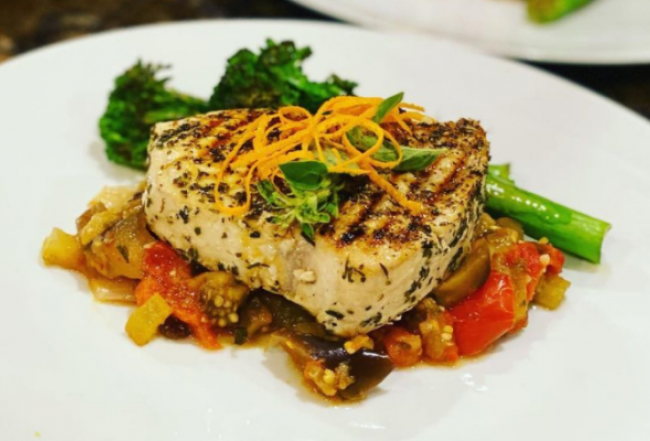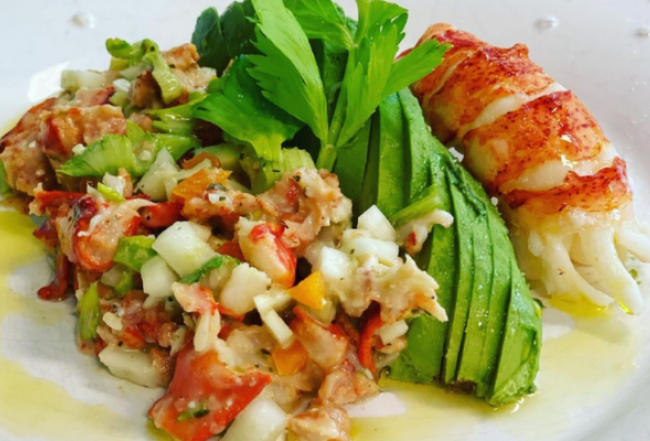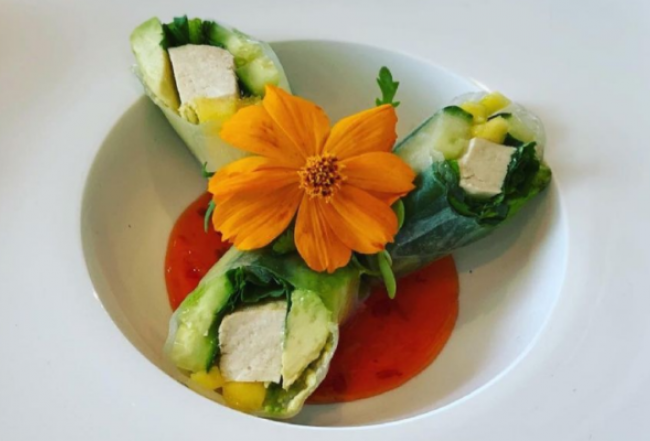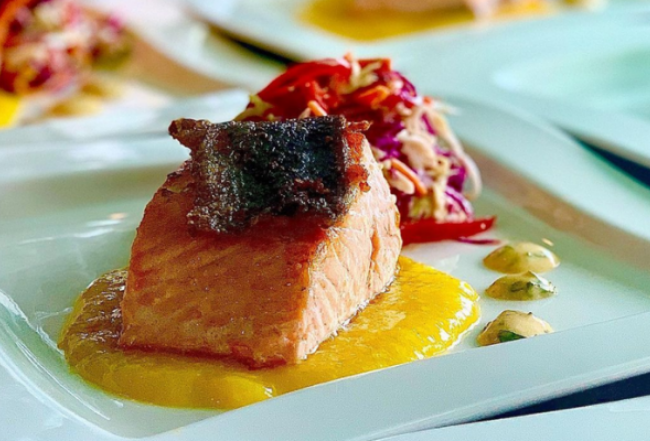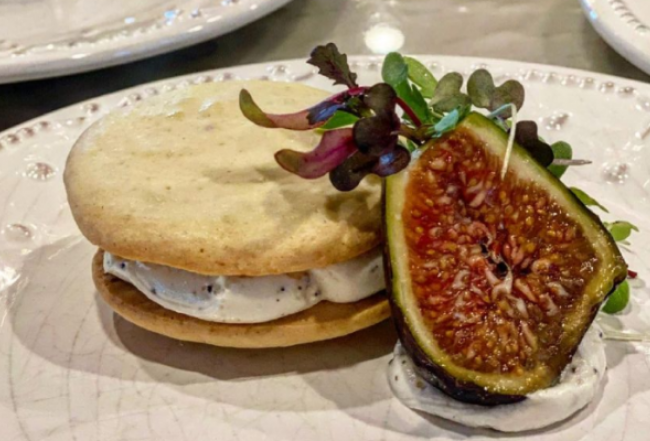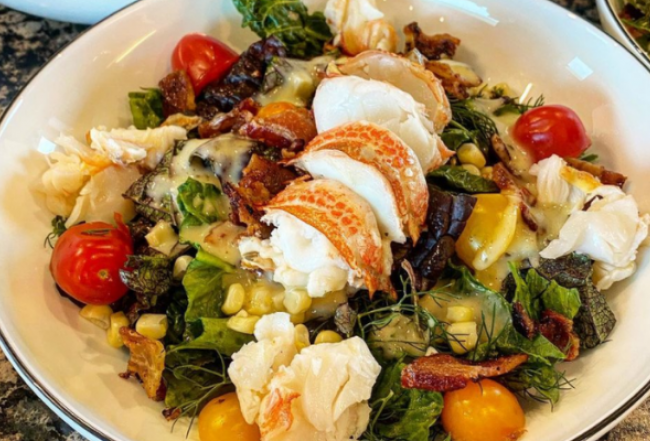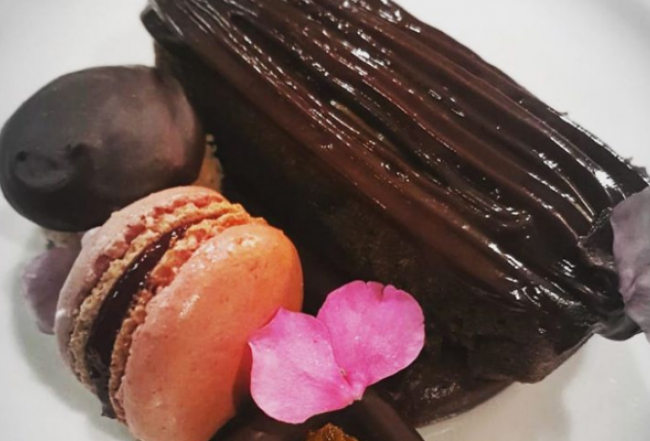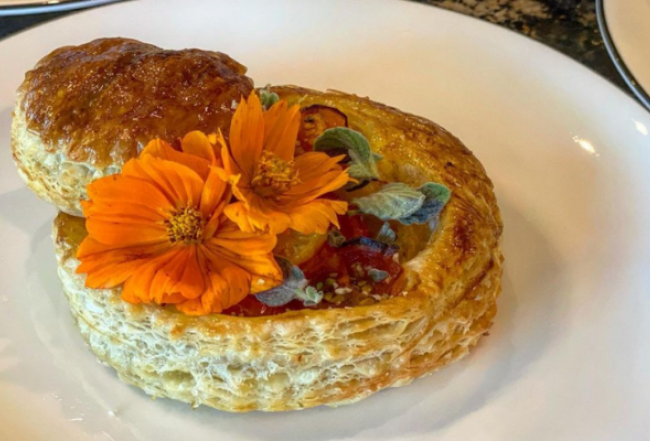Ocean Club
- 50m | Trinity | 2009 (2018)
When Chef Patricia Clark was growing up, her father’s job in the army saw her moving to a number of far-flung places across the globe, and this is how her love of food began. Turning her passion into a career, Patricia went on to complete the Le Cordon Bleu program, training in Italy and working in some of the most prestigious kitchens across the US, Europe and beyond.
Now heading up the galley on board MY Ocean Club, Chef Patricia prides herself on her ability to source out local and sustainable ingredients, even in the most remote of places, yet always has a back-up plan in place to ensure she can curate eclectic menus that take into account all guests’ preferences and dietary restrictions.
“I scout local farms, farmers markets and often call local restaurants for recommendations,” she says. “I have a few vendors who I can always trust to fly in specialty ingredients as needed but I can’t depend on that. Customs can be difficult in some areas, plus weather, Covid, blight, route changes etc can all also affect my ability to source what’s local, so it's always important to have a back-up plan in place.”
From the latest trends on the dining scene to her signature dishes – Chef Patricia whips up a mean pasta dish – the culinary whizz talks us through a luxury foodie experience on board Ocean Club.
Can you tell us a little about your background?
My father was in the army and we moved to many diverse places in my early childhood. I learned to keep an open mind about food and the excitement of the unknown. My career has taken me along both US coasts as well as much of Europe and beyond.
What motivated you to become a chef and where did you train?
The desire to connect with all types of people wherever I found myself in the world. I trained in a few regions of Italy before and after completing the Le Cordon Bleu program.
Who are your chef heroes – who has influenced your style of cooking?
My chef heroes include people who regularly share what they discover with the world. Dan Barber, Richard Knott, Ferran and Albert Adrià, Christina Bowerman. There are so many outstanding chefs pushing the concepts of plating and palates.
How did you come to work as a superyacht chef?
An agency called me to train the chefs in Topaz many years ago because none of them knew how to make any American or Italian dishes for a few surprise guests. It was a great experience, and I loved the camaraderie of the international crew.
What is your favourite type of cuisine?
A fusion of Japanese and Italian.
How would you describe your culinary style?
Seasonal ingredient driven with a focus on customisable comfort.
What’s your signature dish – what has really wowed your guests?
Most guests rave about my pasta dishes, and they are fun to create. I don’t have a signature dish because ingredients change rapidly from one location to the next.
Where do you get inspiration and ideas for creating your own menus?
Sometimes I think I need an inspiration umbrella. Ideas occur to me constantly every day through fashion, sights, art. Cross discipline collaboration menus are my favourite.
What’s your favourite restaurant and why?
Marea in NYC. The food and service are always perfect, and a long walk in a vibrant city after an amazing dinner is the ultimate nightcap.
What’s the secret to cooking high quality food on board compared to ashore?
Planning. I travel as much as possible with my off time and like to collect unusual ingredients. The element of surprise can be hard to create when markets become hard to find. I also try and keep up with a weekly stock, demi-glace, and infused oils schedule.
What are your favourite destinations in terms of local produce?
Umbria, Sardegna and Mallorca.
What’s the most unusual ingredient you’ve come across on your travels?
Biska, a Croatian style Grappa made with mistletoe.
How do you manage special dietary requirements such as vegetarian, vegan and gluten-free?
I try to keep a solid stock of Asian dry goods (rice paper, nori, umeboshi) as well as gluten free flours and alternative sugars. I worked for a long time for a gluten free vegan client, so those kinds of requests are easy for me.
Are you seeing any trends at the moment – what’s on the horizon?
Umami chocolate, cheeses turned into ice creams, and expanding the idea of what is usable from gardens and orchards. I think we will see a lot more chefs and restaurants asking people to try more interesting plant-based concepts such as vines, stalks and even roots after the bolting phase.
As well as creating beautiful dishes, do you get involved in table decoration?
Only in picking the plates. I believe in giving the chief stew a lot of space when it comes to this. Table design is fun but also complicated. The stews have a sense of seating placement, if flowers need to be refreshed, or if we can’t get fresh flowers then how to bring in elegance and whimsy in other ways. I’ve been lucky to work with some talented and efficient interior teams.
I find that describing the day’s dishes in the morning with the stew team gets the best results. We usually have a meeting about the dishes mid-morning and it gets settled then.
Who chooses which wines to stock on board?
That depends on the boat. I’ve had captains who insist on doing it themselves, or chief stews sometimes take that on. I love to do it especially when I can collaborate with the charter principles on their tastes.
What’s your view on sustainable sourcing and buying local wherever possible?
My view is to get as much local as possible but always have a backup plan a week ahead. Weather, Covid, blight, route changes etc all affect my ability to source what’s local. I try and scout local farms, farmers markets and often call local restaurants for recommendations. I have a few vendors who I can always trust to fly in specialty ingredients as needed but I can’t depend on that. Customs can be difficult in some areas.
What do you most enjoy about working as a superyacht chef?
I had a goal for many years that I would consider myself successful when I make nice food for nice people in nice places. Yachting gives me all of this! The bonus is the team dynamic. Chef life can often be solitary, but on the boats the crew becomes family, workout buddies and creative collaborators.
What have been some of the highlights and best moments while working on board MY Ocean Club?
The bonding I get to witness between the guests. Family, friends and business associates all become more relaxed and excited with each day together. I usually chat with guests after dinner and the collective enthusiasm grows with every meal!
What is your future ambition – what would you like to do when you eventually move ashore?
I came to yachting later in my chef career. I just turned 50 last week and I hope to continue in yachting for many years to come. I have worked as a caterer, worked in restaurants, created traveling pop ups, been a location based and traveling private chef – yachting works for me.
When I retire, I just want a little Umbrian farmhouse where friends and close clients visit for epic meals.
Any other comments?
I simply want to thank you the reader. Thank you for the opportunity to tell you a bit about myself and thank you for your trust in the show and with your dining experience.
Sample Tasting Menu
Hors D’oeuvres
Handmade breadsticks with bresola and mostarda
Heirloom radishes
Umbrian black truffle butter
Pate de Campagna
Apple crisps and pistachio dust
Seated Menu
Homemade breads and salted butter
Amuse
Chestnut, roast apple, leek soup
First Course
Handmade raviolo
Smoked carrot, caramelized fennel, white miso and vanilla bean
Second Course
Pacific halibut
Swiss chard, tomato confit and thyme blossoms
Third Course
Roast Chicken
Crispy skin, seared grapes, buttermilk and pink peppercorns
Intermezzo
Amaro Sorbet
Dessert
Fig Panna Cotta
Follow Chef Patricia at @allfivesenses.


